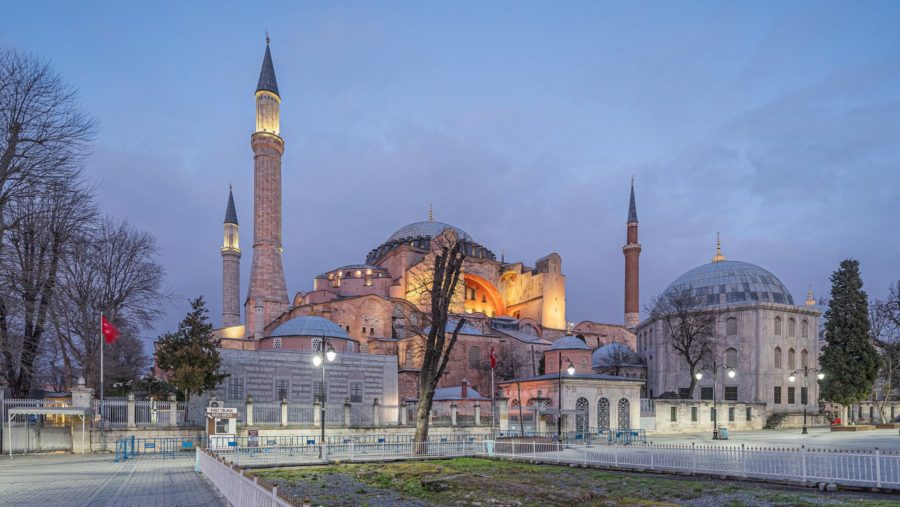DR. TODD M. JOHNSON, Gordon-Conwell Theological Seminary
PROFESSOR OF GLOBAL CHRISTIANITY AND MISSION
When the Hagia Sophia was built in Constantinople in 537 CE,
Christians represented nearly 60% of the population of Western Asia.
Perhaps less known is the fact that, at this same time, Asians and
Africans represented about two thirds of all Christians with only one
third being European (World Christian Encyclopedia 3rd ed.,
page 917). The subsequent rise of Islam would gradually erode the
presence of Christians in the region; by the time of the Ottoman
conquest and the conversion of the Hagia Sophia into a mosque (1453 CE),
the region was only about 20% Christian, with just 10% of all
Christians living in Africa and Asia. Christianity was by then largely a
European faith, with interactions between Christians and Muslims
progressively framed as a conflict between the Christian West and the
Muslim Arab and Turkish World.
Today, in 2020, only 5.4% of the region is Christian. This stark
decline of Christians is pivotal in assessing the role of the Hagia
Sophia in Turkey. Turkish foreign policy expert Ziya Meral
expresses his alarm that “in two decades, the land that played a
fundamental role in the emergence of Christianity will have lost most
traces of it, save a few empty buildings here and there, full of hurried
tourists and guides making up whatever story they can on that day.”
Meanwhile, between the 19th and 20th centuries, Christianity had
spread around the world, such that today, Asians and Africans, along
with Latin Americans and Pacific Islanders, again represent two thirds
of all Christians! In other words, the Christian faith today looks more
like it did when the Hagia Sophia was built in the 6th century than when
it became a mosque in the 15th century. Consequently, rather than just a
Western concern, the Hagia Sophia holds import to Christians throughout
the world, with believers from Brazil, Nigeria, India, China, South
Korea, and the Philippines having made pilgrimages to the Hagia Sophia
and coming home with a renewed appreciation for the Orthodox expression
of their Christian faith.
And yet, despite its long history, the struggle over the Hagia Sophia
reveals some of its deepest faultlines in the 20th century.
In 1900, Turkey had a burgeoning Christian community (21% of the
population), where over 3 million Armenian, Greek, Assyrian, Chaldean
and other Christians had been based for centuries. However, the tragedy
of the Armenian Genocide (also targeting other Christian minorities) and
the forced migration of Armenian and Greek Christians (calamitous “Exchange of Populations,”
supported by Western countries) dramatically altered the landscape. By
1950 less than 1% of the population was Christian. Under these
devastating conditions, the preservation of the Hagia Sophia as a museum
(since 1934) offered some dignity to the remnants of Christians who
remained. In contrast, its conversion to a mosque sends a demoralizing
message to its Christian minorities today (0.2% of the population in
2020). Orthodox scholar George Demacopoulos
writes, “Through genocide, pogroms, property confiscation, harassment,
and historical revision, Turkish leaders have demonstrated, time and
again, that they have no interest in recognizing—let alone
protecting—the Christian minorities of their nation.”
While Christianity was shifting to the Global South, Islam was
growing far beyond the Middle East. In 1900 Turkey represented 5.5% of
all Muslims worldwide, today that has fallen to 4.3%. At the same time,
Muslims of the wider Middle East (Morocco to Iran) represented about 30%
of all Muslims in 1900 but this had fallen to under 25% by 2020. Over
time, Muslims have lived with much less diversity. In 1900, 54% of all
Muslims lived in countries 50% or more Muslim but this grew to 73% by
2020. Turkish political commentator Mustafa Akyol
has pointed out how Islam has a rich history of supporting religious
pluralism, a virtue based in the Quran. Muslims generally did not
convert the shrines of subjugated peoples; rather, the conversion of
churches into mosques came instead from “administration regulation” or
the needs of empire. Akyol sees a choice between power (restoration of
Ottoman grandeur) and virtue (multireligious coexistence) in Turkey’s
stewardship of the Hagia Sophia. He, with many other Muslims, would like
to see global Islam engage positively with other religions around the
world. In similar fashion, many Christians would also like to see their
global faith embrace the challenge of religious diversity in the spirit
of benevolence found in the Bible.
The relationship between Christianity and Islam is critical for the
future of the planet. Christians and Muslims together represented only
20% of the world’s population in 1453, growing to 57% today (and will
likely to rise to 67% after 2050). Turkey still has an opportunity to
show its commitment to the rights of all its peoples in choosing virtue
over power. The Hagia Sophia is an important symbol of both religions,
including their evolution over time, and has the opportunity to help
resolve tensions today and in the future.

